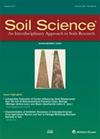Identification of thermal signature and quantification of charcoal in soil using differential scanning calorimetry and benzene polycarboxylic acid (BPCA) markers
4区 农林科学
Q2 Agricultural and Biological Sciences
引用次数: 2
Abstract
Abstract. Black carbon (BC) plays an important role in terrestrial carbon storage and can sustainably improve soil fertility. However, the accurate quantification of BC remains critical to fully unravelling the functions and dynamics of BC in soil. In this study, we explored the potential of differential scanning calorimetry (DSC) to identify, characterize and quantify charcoal in the soil of pre-industrial charcoal kiln sites from various forest and cropland areas in Belgium and Germany. Pre-industrial charcoals and uncharred soil organic matter (SOM) demonstrated a distinct thermal signature that could be used to distinguish between them, with charcoal being more thermally stable than SOM. The DSC pattern of charcoals was characterized by one to three specific exothermic peaks, varying in size and position depending on soil conditions. Our data suggest that the thermal moieties within charcoal depend on the strength of chemical bonds of C atoms (increasing with the degree of aromatic condensation and decreasing with weathering) and on the activation energy required to initiate combustion. Despite the specific thermal features of charcoal, its decomposition spans a wide range of temperatures that overlaps with the thermal signature of uncharred SOM. This stresses the challenge of BC quantification in soil and hinders the use of cut-off temperatures to accurately quantify charcoal in soil. Therefore, charcoal-C content was estimated from the relative height of exothermic peaks, attributed either to the combustion of charcoal or SOM. For a selection of 45 soil samples, charcoal-C content estimated by DSC was compared to benzene polycarboxylic acid (BPCA) abundance, a widely used method to quantify BC in soil. The two methods correlated strongly (R2=0.97), with BPCA C representing about one-fifth of DSC-derived charcoal C. This reinforces the view that operationally defined BC content has an absolute quantitative value only if the recovery rate is controlled, which is very complicated for many case studies. Overall, our results demonstrate that dynamic thermal analysis is largely under-exploited despite providing quantitatively interpretable information across the continuum of SOM.用差示扫描量热法和苯聚羧酸(BPCA)标记物鉴定土壤中木炭的热特征和定量
摘要黑碳在陆地碳储存中起着重要作用,能够持续提高土壤肥力。然而,准确的定量仍然是充分揭示土壤中BC的功能和动态的关键。在这项研究中,我们探索了差示扫描量热法(DSC)在鉴定、表征和量化比利时和德国不同森林和农田地区工业化前炭窑遗址土壤中木炭的潜力。工业化前的木炭和未烧焦的土壤有机质(SOM)表现出明显的热特征,可以用来区分它们,木炭比SOM更热稳定。不同土壤条件下,炭的dsc分布特征为1 ~ 3个特定的放热峰,其大小和位置随土壤条件的不同而变化。我们的数据表明,木炭中的热组分取决于C原子化学键的强度(随着芳香缩合程度的增加而增加,随着风化而减少)和启动燃烧所需的活化能。尽管木炭具有特定的热特征,但其分解的温度范围很广,与未烧焦的SOM的热特征重叠。这强调了土壤中碳量化的挑战,并阻碍了使用截止温度来准确量化土壤中的碳。因此,炭- c含量是根据由木炭或SOM燃烧引起的放热峰的相对高度来估计的。选取了45个土壤样品,将DSC估算的碳碳含量与苯聚羧酸(BPCA)丰度进行了比较,BPCA是一种广泛使用的量化土壤中碳碳含量的方法。这两种方法相关性很强(R2=0.97),其中BPCA约占dsc衍生木炭c的五分之一。这加强了这样一种观点,即只有在回收率得到控制的情况下,操作定义的BC含量才具有绝对的定量值,这对于许多案例研究来说是非常复杂的。总体而言,我们的研究结果表明,尽管动态热分析在SOM连续体中提供了定量可解释的信息,但在很大程度上尚未得到充分利用。
本文章由计算机程序翻译,如有差异,请以英文原文为准。
求助全文
约1分钟内获得全文
求助全文
来源期刊

Soil Science
农林科学-土壤科学
CiteScore
2.70
自引率
0.00%
发文量
0
审稿时长
4.4 months
期刊介绍:
Cessation.Soil Science satisfies the professional needs of all scientists and laboratory personnel involved in soil and plant research by publishing primary research reports and critical reviews of basic and applied soil science, especially as it relates to soil and plant studies and general environmental soil science.
Each month, Soil Science presents authoritative research articles from an impressive array of discipline: soil chemistry and biochemistry, physics, fertility and nutrition, soil genesis and morphology, soil microbiology and mineralogy. Of immediate relevance to soil scientists-both industrial and academic-this unique publication also has long-range value for agronomists and environmental scientists.
 求助内容:
求助内容: 应助结果提醒方式:
应助结果提醒方式:


